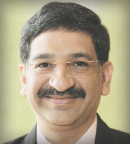
Jame Abraham, MD, FACP
Among the high-quality abstract presentations at the San Antonio Breast Cancer Symposium (SABCS), a few always stand out as particularly meritorious. Each year, The ASCOPost asks our Associate Editor, breast cancer specialist Jame Abraham, MD, FACP, to give us his picks. Dr. Abraham is Chairman of the Department of Hematology and Medical Oncology at Cleveland Clinic and Professor of Medicine at Lerner College of Medicine. Here are his “Top 7” from the 2022 SABCS.
TRIO-US B-12: Neoadjuvant T-DXd in HER2-Low Tumors
TRIO-US B-12 TALENT evaluated neoadjuvant fam-trastuzumab deruxtecan-nxki (T-DXd) alone or in combination with anastrozole and found this strategy produced responses in 68% and 58% of patients, respectively, reported Aditya Bardia, MD, MPH.1 Almost half (48.6%) had a change in HER2 immunohistochemistry (IHC) expression after T-DXd treatment, mostly (88.2%) a decrease in expression.

Aditya Bardia, MD, MPH
The study included 58 patients with hormone receptor–positive HER2-low (mostly IHC 1+) operable stage II or III tumors. Patients were randomly assigned to receive either T-DXd alone or with anastrozole for six cycles, later amended to eight cycles.
The overall response rate (primary endpoint) was 68% with T-DXd and 58% with T-DXd plus anastrozole. For the 42 patients with data on residual cancer burden, the rate of combined pathologic or near pathologic complete response was approximately 15% in each arm. The addition of endocrine therapy to T-DXd did not appear to enhance efficacy, but the investigators cautioned against making conclusions here, as the patient numbers were small.
Dr. Abraham: The TRIO-US B-12 TALENT trial builds upon the exciting findings of the DESTINY-Breast04 study, which established the benefit of T-DXd in HER2-low tumors. Those practice-changing findings led us to ask whether we could move T-DXd into an earlier setting for patients with HER2-low disease. The trial included both a T-DXd monotherapy arm and a second arm pairing it with endocrine therapy, the rationale being there is documented “crosstalk” between the estrogen receptor (ER) and HER2.
This was an effort to improve upon the conventional regimen of an anthracycline/taxane in patients with high-risk hormone receptor–positive tumors, which is associated with low pathologic complete response rates (5%); fairly low radiologic response rates (50%); and significant toxicities, including neuropathy, cardiomyopathy, and risk of leukemia.
TRIO-US B-12 TALENT did indeed demonstrate preliminary evidence of clinical activity in a subset of patients who usually do not respond well to neoadjuvant chemotherapy. Although this study did not compare T-DXd with chemotherapy, it is a good first step. A response rate of almost 70% in these patients is impressive.
It was discouraging that there was only modest HER2 IHC concordance between central and local laboratories, which highlights the need for better analytic tools for HER2-low detection and better standardization of this process. TRIO-US B-12 TALENT can serve as a platform for additional translational research to evaluate more sensitive methods of HER2 detection, develop predictive biomarkers, and understand mechanisms of resistance in residual disease. Such understanding could guide subsequent treatment approaches, including combination therapy.
POSITIVE Trial: Break in Endocrine Therapy to Pursue Pregnancy Is Safe
Long-term adjuvant endocrine therapy may compromise fertility, and this is a concern for many young women with hormone receptor–positive early breast cancer. Results of the POSITIVE trial, presented by Ann H. Partridge, MD, MPH, showed that these young patients may safely interrupt endocrine therapy for up to 2 years to pursue pregnancy.2
The single-arm international POSITIVE trial enrolled 516 patients from 20 countries. The median age of patients was 37. Those desiring to become pregnant had undergone 18 to 30 months of adjuvant endocrine therapy, and following a 3-month washout period, they were encouraged to attempt to conceive. The median time to resuming endocrine therapy was 2 years.

Ann H. Partridge, MD, MPH
At a median follow-up of 41 months, 507 pregnancies were reported, and 86% had at least one live birth. One or more miscarriages were reported by 19%, and abortions, by 3%. These pregnancies were achieved without compromising oncologic outcomes. The 3-year rate of breast cancer recurrence was 8.9%—a rate that compares favorably with the 9.2% rate in the TEXT/SOFT trial, whose population would have been eligible for POSITIVE. Distant recurrence rates were 4.5% in POSITIVE and 5.6% in SOFT/TEXT.
Dr. Abraham: The kind of data we now have from the POSITIVE trial has been missing from our field. The findings will certainly be reassuring to young hormone receptor–positive women who would like to become pregnant, as well as their oncologists. The study shows we canstop endocrine therapy for up to 2 years and allow our patients to grow their families, then restart endocrine therapy without negatively impacting breast cancer outcomes. It is important to make clear, however, that this approach interrupts endocrine therapy but does not allow its discontinuation. The findings also highlightthe need to incorporate patient-centered reproductive health care in the management of young women with breast cancer.
Capivasertib Plus Fulvestrant Doubles Progression-Free Survival
In the phase III CAPItello-291 trial, capivasertib—an AKT pathway inhibitor—plus fulvestrant significantly improved progression-free survival compared with fulvestrant alone in a study of 708 patients with previously treated hormone receptor–positive, HER2-negative advanced breast cancer, including those with AKT pathway–altered tumors.3

Nicholas C. Turner, MD, PhD
In the overall trial population, median progression-free survival was doubled with capivasertib plus fulvestrant, from a median of 3.6 months with fulvestrant alone to 7.2 months with the combination—a 40% reduction in risk (P < .001). In patients harboring AKT pathway–mutated tumors, median progression-free survival was also doubled, from 3.1 months to 7.3 months with the combination—a 50% reduction in risk (P < .001), according to Nicholas C. Turner, MD, PhD. The overall survival analysis at 28% maturity showed a 26% reduction in the risk of death in the overall population and a 31% risk reduction in the AKT pathway–altered group in the capivasertib-plus-fulvestrant arms. Grade ≥ 3 adverse events were more common in the capivasertib group.
Dr. Abraham: TheCAPItello trial has shown that capivasertib is an exciting new drug that appears active in patients with hormone receptor–positive, HER2-negative metastatic disease, regardless of activity in the AKT pathway. We hope this will be a good second-line option for certain patients, and for this, we will need to consider which patients can fare well on monotherapy and which will be appropriate for capivasertib plus chemotherapy. It is interesting to note that the majority of patients on this trial had prior treatment with a cyclin-dependent kinase 4 and 6 (CDK4/6) inhibitor.
EMERALD: Elacestrant Now an Option for Endocrine Monotherapy
In the registrational phase III EMERALD study, elacestrant, a recently approved oral selective estrogen receptor degrader (SERD), achieved longer progression-free survival than standard-of-care endocrine monotherapy as second- or third-line therapy in patients with estrogen receptor–positive, HER2-negative advanced or metastatic breast cancer.4 The 478 patients in the EMERALD trial were all previously treated with CDK4/6 inhibitors in addition to endocrine therapy. The latest analysis of EMERALD showed a median progression-free survival of up to 8.6 months, depending on the duration of prior CDK4/6 inhibitor therapy, said Virginia Kaklamani, MD.

Virginia Kaklamani, MD
A post hoc analysis showed that longer duration of prior CDK4/6 inhibitor therapy was positively associated with longer progression-free survival with elacestrant but not with standard therapy. For example, for patients exposed to CDK4/6 inhibitors for at least 18 months, median progression-free survival was 5.5 months with elacestrant vs 3.3 months with standard therapy—a 30% reduction in risk. Among the ESR1-mutated population with at least 18 months of prior exposure to CDK4/6 inhibitors, median progression-free survival was 8.6 months with elacestrant vs 2.1 months with standard therapy—a 53% reduction in risk.
Dr. Abraham: The findings of the EMERALD study suggest elacestrant may have the potential to become a new standard of care as a single-agent endocrine-sequencing option, before moving to combination therapy or other intravenous systemic therapy options, in estrogen receptor–positive, HER2-negative advanced breast cancer that progresses on CDK4/6 inhibitors and endocrine therapy. The benefit was most striking in patients with ESR1-mutated tumors, many of whom experienced a prolonged progression-free survival. On the other hand, for ESR1 wild-type tumors, elacestrant appears on par with other endocrine therapies. Choosing between this SERD and standard endocrine therapies, therefore, would depend on their relative side-effect profiles and the patient’s preference for intramuscular vs oral medication (and we lack real-world data on compliance with elacestrant).
“The benefit [of elacestrant in the EMERALD trial] was most striking in patients with ESR1-mutated tumors, many of whom experienced a prolonged progression-free survival.”— JAME ABRAHAM, MD, FACP
Tweet this quote
But it is exciting that the FDA approved elacestrant for for postmenopausal women or adult men with ER-positive, HER2-negative, ESR1-mutated advanced or metastatic breast cancer with disease progression following at least one line of endocrine therapy.
Elacestrant is not the right therapy for every patient. In particular, we need to identify those who are endocrine-sensitive, as most of the benefit is seen in patients withat least 12 months of CDK4/6 inhibitor exposure, which is a marker for endocrine sensitivity. This is currently based on clinical assessment—primarily, duration of prior CDK4/6 inhibitor therapy.
Interim Survival Analysis in monarchE
In a planned interim overall survival analysis of the monarchE trial, which evaluated adjuvant abemaciclib in patients with hormone receptor–positive, HER2-negative, high-risk, node-positive breast cancer, the benefit of adjuvant abemaciclib deepened in magnitude: there were larger increases in absolute invasive disease–free survival and distant recurrence–free survival benefits at 4 years, as compared with 2 and 3 years, according to Stephen R.D. Johnston, MD, PhD.5
At the 4-year mark, the difference in invasive disease–free survival favoring abemaciclib was 6.4%, compared with a 4.8% difference observed at 3 years and a 2.8% difference at 2 years. Ki67 remained prognostic, but the abemaciclib benefit was similar regardless of the Ki67 index. Although overall survival remains immature, fewer deaths were observed with abemaciclib plus endocrine therapy.

Stephen R.D. Johnston, MD, PhD
The randomized open-label phase III monarchE trial enrolled 5,637 patients with hormone receptor–positive, HER2-negative, node-positive early-stage breast cancer deemed at high risk based on clinical pathologic features. Patients received 2 years of treatment with endocrine therapy (aromatase inhibitor or tamoxifen) alone or with abemaciclib at 150 mg twice daily.
After 4 years, invasive disease–free survival was 85.8% with abemaciclib plus endocrine therapy vs 79.4% with endocrine therapy alone (hazard ratio [HR] = 0.664; P < .0001). Beyond the completion of treatment, a distant relapse–free survival benefit persisted, with a 4-year rate of 88.4% vs 82.5%, respectively (HR = 0.659; P < .0001). For both invasive disease–free and distant relapse–free survival, the hazard ratios became more favorable over time, further supporting the potential of a carryover effect. Similar treatment effects were observed regardless of Ki67 values. A numeric difference in overall survival appears to be emerging.
“The updated results of monarchE are particularly important, as we were concerned that with longer follow-up, the progression-free survival curves might converge, as we saw with palbociclib in the PENELOPE-B trial.”— JAME ABRAHAM, MD, FACP
Tweet this quote
Dr. Abraham: The updated results of monarchE are particularly important, as we were concerned that with longer follow-up, the progression-free survival curves might converge, as we saw with palbociclib in the PENELOPE-B trial. This update tells us that the invasive disease–free survival benefits of adjuvant abemaciclib are not only seen in the first 2 years, ie, during treatment, but are maintained thereafter, with further separation of the curves as compared with years 2 and 3. In addition, a Ki67 index greater than 20% continued to be an indicator of worse prognosis, but similar benefit was derived from abemaciclib/endocrine therapy regardless of the Ki67 level.
RIGHT Choice: Ribociclib Plus Endocrine Therapy for Visceral Crisis
According to findings from the phase II RIGHT Choice trial, premenopausal patients with metastatic hormone receptor–positive, HER2-negative breast cancer experiencing visceral crisis are best treated with first-line ribociclib plus endocrine therapy rather than with chemotherapy.6 The combination led to a doubling in median progression-free survival compared with standard chemotherapy and was associated with fewer adverse events, according to Yen-Shen Lu, MD, PhD.

Yen-Shen Lu, MD, PhD
The trial enrolled 222 pre- or perimenopausal women with hormone receptor–positive, HER2-negative previously untreated aggressive breast cancer. More than half (52%) were determined to be in visceral crisis, as indicated by rapidly progressing disease or impending visceral compromise, symptomatic visceral metastases, or markedly symptomatic nonvisceral disease. Patients received ribociclib at 600 mg daily for 3 weeks on, 1 week off, given with letrozole or anastrozole plus goserelin, or investigator’s choice of combination chemotherapy, which could be docetaxel plus capecitabine, paclitaxel plus gemcitabine, or capecitabine plus vinorelbine.
After a median follow-up of 24 months, median progression-free survival was 24.0 months with ribociclib/endocrine therapy compared with 12.3 months with combination chemotherapy (hazard ratio [HR] = 0.54; P = .0007). Overall response rate was 65.2% vs 60.0%, respectively, and time to response was 4.9 months vs 3.2 months. The ribociclib arm was also better tolerated.
Dr. Abraham: The RIGHT Choice trial addresses an important clinical question: Do patients with rapidly progressing visceral disease, or even nonvisceral disease that is highly symptomatic, need upfront chemotherapy, or can they still benefit from what is now the standard of care: a CDK4/6 inhibitor and endocrine therapy? Many guidelines have continued to recommend chemotherapy in this setting, one reason being its prompt onset and likelihood of response. Interestingly, in this study, the response rates between the arms were similar—eliminating response as a factor in treatment selection. Of note, the CDK4/6 inhibitor plus endocrine therapy actually delayed disease progression by a full year, vs chemotherapy. Since younger patients with aggressive disease often demonstrate treatment resistance and thus have worse outcomes, this finding is impressive and important.
One caveat that has been noted about this trial, however, is its use of the historical definition of visceral crisis, which is not completely in line with current practice. Also, performance status of the patients was primarily Eastern Cooperative Oncology Group 0 or 1, which seems a bit contradictory to the idea of visceral crisis. To me, this means there may still be some patients for whom the data are not applicable. The study does support the use of ribociclib plus endocrine therapy in the majority of patients with advanced disease, but there will still be some patients who need chemotherapy.
Neoadjuvant Chemotherapy in Triple-Negative Disease: Carboplatin’s Benefit
In a phase III randomized trial conducted by researchers at Tata Memorial Hospital in India, the addition of weekly carboplatin to standard taxane/anthracycline–based neoadjuvant chemotherapy improved pathologic complete response rates, event-free survival, and overall survival in patients with triple-negative breast cancer aged up to age 50, reported Sudeep Gupta, MD.7
The study enrolled 720 patients with triple-negative breast cancer, clinical T stage 1 to 4, clinical nodal status 0 to 3, and no evidence of metastatic disease. About 70% of patients were aged 50 or younger, and 60% were premenopausal. Patients were randomly assigned to receive paclitaxel at 100 mg/m2 with or without carboplatin at AUC2 given once per week for 8 weeks, followed by four cycles of standard anthracycline/cyclophosphamide, then surgery and radiotherapy.

Sudeep Gupta, MD
The addition of weekly carboplatin resulted in absolute increases in 5-year event-free survival and overall survival, driven entirely by the benefit in patients up to age 50. In this younger cohort, the absolute increase in 5-year event-free survival was 12.5% (HR = 0.642; P = .004), and the absolute increase in overall survival was 11.2% (HR = 0.611; P = .003). Also in the younger cohort, carboplatin led to 14.2% more pathologic complete responses. The platinum arm did have more patients with grade ≥ 3 neutropenia, anemia, thrombocytopenia, and febrile neutropenia, but nonhematologic toxicity rates were similar.
Dr. Abraham: The addition of carboplatin to standard neoadjuvant chemotherapy for early-stage triple-negative breast cancer has been controversial. No survival advantage was shown with adjuvant carboplatin in CALBG 40603 or ECOG-ACRIN E1131. In contrast, GeparSixto and BrighTNess did demonstrate increased disease-free survival and event-free survival, respectively, as secondary endpoints with the addition of carboplatin. Carboplatin is also included as part of chemotherapy plus pembrolizumab in the neoadjuvant setting, based on KEYNOTE-522.
Now, this study’s supporting data suggest that the addition of carboplatin to taxane/anthracycline neoadjuvant chemotherapy should be standard treatment in patients with triple-negative breast cancer who are aged 50 or younger or who are premenopausal. The achievement of a pathologic complete response benefit is consistent with prior studies, and the trial also demonstrated an event-free and overall survival benefit in the younger subgroup—though there is as yet no explanation for the discrepancy in benefit between patients up to age 50 (or premenopausal) and those older than age 50. Since carboplatin is not without toxicity, it should be used judiciously in the neoadjuvant setting.
DISCLOSURE: Dr. Abraham has received institutional research support from Pfizer, Seattle Genetics, and Daiichi Sankyo.
REFERENCES
1. Hurvitz SA, Bardia A, Press MF, et al: TRIO-US B-12 TALENT: Neoadjuvant trastuzumab deruxtecan with or without anastrozole for HER2-low, HR+ early stage breast cancer. 2022 San Antonio Breast Cancer Symposium. Abstract GS2-03. Presented December 7, 2022.
2. Partridge A, Niman SM, Ruggeri M, et al: Pregnancy outcome and safety of interrupting therapy for women with endocrine responsive breast cancer: Primary results from the POSITIVE trial. 2022 San Antonio Breast Cancer Symposium. Abstract GS4-09. Presented December 9, 2022.
3. Turner N, Oliveria M, Howell SJ, et al: Capivasertib and fulvestrant for patients with aromatase inhibitor-resistant hormone receptor-positive/human epidermal growth factor receptor 2-negative advanced breast cancer: Results from the phase III CAPItello-291 trial. 2022 San Antonio Breast Cancer Symposium. Abstract GS3-04. Presented December 8, 2022.
4. Kaklamani V, Bidard FC, Neven P, et al: EMERALD phase 3 trial of elacestrant versus standard of care endocrine therapy in patients with ER+, HER2– metastatic breast cancer: Updated results by duration of prior CDK4/6 inhibitor in the metastatic setting. 2022 San Antonio Breast Cancer Symposium. Abstract GS3-01. Presented December 8, 2022.
5. Johnston SRD, Toi M, O’Shaughnessy J, et al: Abemaciclib plus endocrine therapy for HR+, HER2– node-positive, high-risk early breast cancer: Results from a pre-planned monarchE overall survival interim analysis, including 4-year efficacy outcomes. 2022 San Antonio Breast Cancer Symposium. Abstract GS1-09. Presented December 6, 2022.
6. Lu YS, Bin Mohd Mahidin EI, Azim H, et al: Primary results from the randomized phase II RIGHT Choice trial of premenopausal patients with aggressive hormone receptor-positive HER2-negative advanced breast cancer treated with ribociclib plus endocrine therapy vs physician’s choice combination chemotherapy. 2022 San Antonio Breast Cancer Symposium. Abstract GS1-10. Presented December 6, 2022.
7. Gupta S, Nair NS, Hawaldar RW, et al: Addition of platinum to sequential taxane-anthracycline neoadjuvant chemotherapy in patients with triple-negative breast cancer: A phase III randomized controlled trial. 2022 San Antonio Breast Cancer Symposium. Abstract GS5-01. Presented December 9, 2022.

